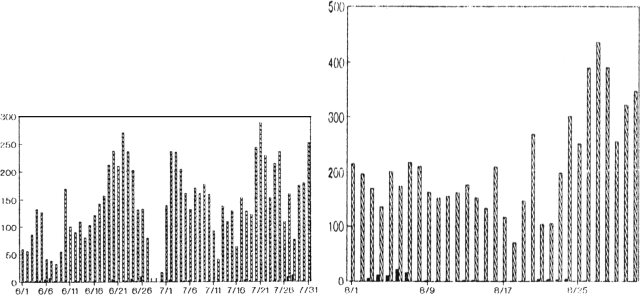Report on Poas (Costa Rica) — August 1989
Scientific Event Alert Network Bulletin, vol. 14, no. 8 (August 1989)
Managing Editor: Lindsay McClelland.
Poas (Costa Rica) Sulfur flows and acid rain; earthquakes and tremor
Please cite this report as:
Global Volcanism Program, 1989. Report on Poas (Costa Rica) (McClelland, L., ed.). Scientific Event Alert Network Bulletin, 14:8. Smithsonian Institution. https://doi.org/10.5479/si.GVP.SEAN198908-345040
Poas
Costa Rica
10.2°N, 84.233°W; summit elev. 2697 m
All times are local (unless otherwise noted)
Emission of sulfurous gases from the hot crater lake remained continuous through August. Winds carried the gases mainly W and SW, producing acid rain that has continued to burn flank vegetation. The lake level remained low, fluctuating with changes in the relative amounts of evaporation and loss through fumarole emissions vs. rainfall and recondensation of fumarolic water. Temperatures oscillated between 80° and 86°C and pH was 0-0.5. On the N side of the lake were a field of sulfur and mud cones, fumaroles that made jet-engine sounds, sulfur lakes, and castle-like structures of cones and spines. The sulfur lake on the NE side had produced numerous brilliant yellow sulfur flows that were up to 30 m long, a few meters wide, and a few centimeters thick. More viscous greenish-yellow sulfur/mud flows had pahoehoe morphologies. At the lake's SE end, there were mud and sulfur springs, mud/sulfur/sulfate cones, and fumaroles that discharged gases (dominantly water vapor with a sulfurous component) with small audible explosions. Fumarole temperatures of 120°C were measured at some of the mud/sulfur cones. The outer portion of the lake was blue-green, but suspended mud generated by continuous bubbling from tens of small fumaroles on the lake bottom colored the lake's inner portion gray.
The Univ Nacional continued to record low-frequency (1.5-3.2 Hz) shocks with amplitudes of 4-30 mm, some higher frequency (A-type) events, and occasional low-frequency (1.5-3 Hz) harmonic tremor episodes of 2.5-5 mm amplitude (figure 21). The number of events recorded by Red Sismológica Nacional station VPS-2 increased from an average of 143/day in July to 195/day for the first 29 days of August. Univ Nacional seismic stations recorded slightly more events (daily means of 127 in June, 159 in July, and 235 in August) but showed similar trends.
Geological Summary. The broad vegetated edifice of Poás, one of the most active volcanoes of Costa Rica, contains three craters along a N-S line. The frequently visited multi-hued summit crater lakes of the basaltic-to-dacitic volcano are easily accessible by vehicle from the nearby capital city of San José. A N-S-trending fissure cutting the complex stratovolcano extends to the lower N flank, where it has produced the Congo stratovolcano and several lake-filled maars. The southernmost of the two summit crater lakes, Botos, last erupted about 7,500 years ago. The more prominent geothermally heated northern lake, Laguna Caliente, is one of the world's most acidic natural lakes, with a pH of near zero. It has been the site of frequent phreatic and phreatomagmatic eruptions since an eruption was reported in 1828. Eruptions often include geyser-like ejections of crater-lake water.
Information Contacts: J. Barquero, E. Fernández, and V. Barboza, OVSICORI; G. Soto, Mario Fernández, and Héctor Flores, UCR.


